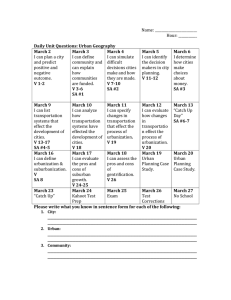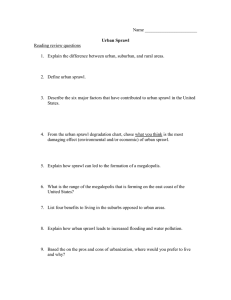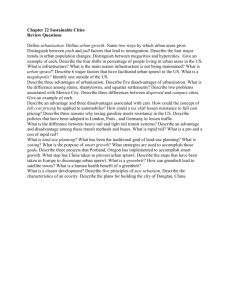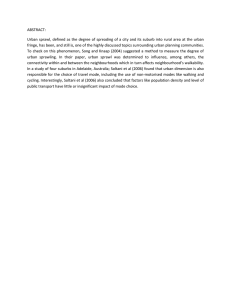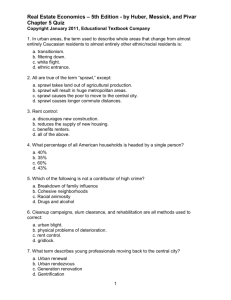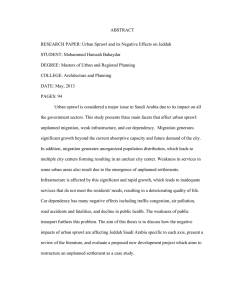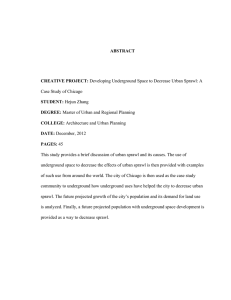CHAPTER 1 INTRODUCTION 1.1
advertisement
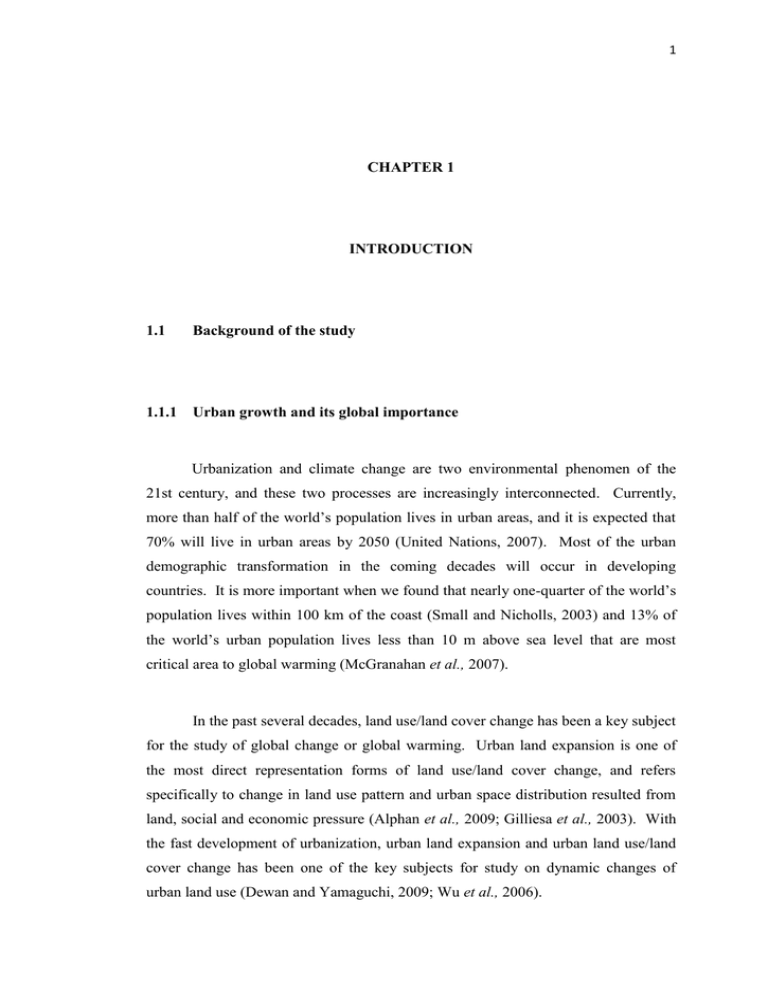
1 CHAPTER 1 INTRODUCTION 1.1 Background of the study 1.1.1 Urban growth and its global importance Urbanization and climate change are two environmental phenomen of the 21st century, and these two processes are increasingly interconnected. Currently, more than half of the world‟s population lives in urban areas, and it is expected that 70% will live in urban areas by 2050 (United Nations, 2007). Most of the urban demographic transformation in the coming decades will occur in developing countries. It is more important when we found that nearly one-quarter of the world‟s population lives within 100 km of the coast (Small and Nicholls, 2003) and 13% of the world‟s urban population lives less than 10 m above sea level that are most critical area to global warming (McGranahan et al., 2007). In the past several decades, land use/land cover change has been a key subject for the study of global change or global warming. Urban land expansion is one of the most direct representation forms of land use/land cover change, and refers specifically to change in land use pattern and urban space distribution resulted from land, social and economic pressure (Alphan et al., 2009; Gilliesa et al., 2003). With the fast development of urbanization, urban land expansion and urban land use/land cover change has been one of the key subjects for study on dynamic changes of urban land use (Dewan and Yamaguchi, 2009; Wu et al., 2006). 2 Although the world's urban areas only account for approximately 3% of the planet's terrestrial surface, impacts of urbanization on the environment and ecosystem services are far reaching, affecting global biogeochemical cycles, climate, and hydrologic regimes (Foley et al., 2005; Grimm et al., 2008). Therefore, research on how ecosystems are transformed by urbanization and especially land conversion of peri-urban environments has been identified as a pivotal area of future land change research (GLP, 2005). Currently, our understanding of both current and future patterns of global urban land-use is poor and fragmented. This is largely due to an uneven global distribution of urban land-use studies. A majority of studies focus on urbanizing regions in developed countries, but there are comparatively few studies of urban land-use change in the rest of the world. The lack of understanding about past urban land-use processes limits our ability to identify regions at risk for urban development. Most of our understanding about global urban land-use comes from case studies on individual cities or regions (Xiao et al., 2006, Geymen and Baz, 2008, Schneider and Woodcock, 2008). From these individual case studies is emerging a picture of varied rates of urban land-use change around the world. Rates of urban land-use change are highest in Asia and some areas in South America and are strongly correlated with patterns of economic development (Schneider and Woodcock, 2008, Angel et al., 2005). When economic development is driven by shifts in the economy from agriculture to manufacturing, it leads to more expansive urban land-use change than the economic transition from manufacturing to services (Guneralp and Seto, 2008). Land change science, including urban land-use change, is emerging as a fundamental component of global environmental change (Turner et al., 2007). Given the increasing importance of urban areas in driving and being impacted by global environmental change, there is urgent need to understand how urban areas evolve, and how and where they may develop in the future. 3 1.1.2 Urban Sprawl Urban sprawl, a consequence of socioeconomic development under certain circumstances, has increasingly become a major issue facing many metropolitan areas, although a general consensus regarding the definition and impact of urban sprawl has not been achieved (Johnson, 2001). Urban sprawl as a concept suffers from difficulties in definition (Angel et al., 2007; Barnes et al., 2001; Johnson 2001; Roca et al., 2004; Sudhira and Ramachandra, 2007; Wilson et al., 2003). Galster et al., (2001) review of the literature found that sprawl can alternatively or simultaneously refer to: (i) certain patterns of land-use, (ii) processes of land development, (iii) causes of particular land-use behaviors, and (iv) consequences of land-use behaviors. They reviewed many definitions of sprawl from different perspectives. Urban sprawl is often discussed without any associated definition at all. Some researchers make no attempt at definition while others „„engage in little more than emotional rhetoric‟‟ (Harvey and Clark, 1965). Johnson (2001) presented several alternative definitions for consideration, concluded that there is no common consensus. Because sprawl is demonized by some and discounted by others, how sprawl is defined depends on the perspective of who presents the definition (Barnes et al., 2001). Wilson et al., (2003) argued that the sprawl phenomenon seeks to describe rather than define. Galster et al., (2001) also emphasized describing the sprawl rather than defining. Accurate definition of urban sprawl, although is debated, a general consensus is that urban sprawl is uncontrolled, scattered suburban development that increases traffic problems, depletes local resources, and destroys open space (Peiser, 2001). The direct implication of sprawl is change in land-use and land-cover of the region as sprawl induces the increase in built-up and paved area (Sudhira and Ramachandra, 2007). It is worth mentioning that opinions on sprawl held by researchers, policy makers, activists, and the public differ sharply; and the lack of agreement over how to define the sprawl certainly complicates the efforts to characterize and restrict this 4 type of land development (Bhatta, 2010). Wilson et al., (2003) argued that without a universal definition, quantification and modeling of urban sprawl is extremely difficult. Creating an urban growth model instead of an urban sprawl model allows us to quantify the amount of land that has changed to urban uses (Angel et al., 2007). It is critically important to properly characterize urban sprawl in order to develop a comprehensive understanding of the causes and effects of urbanization processes. However, due to its association with poorly planned urban land use and economic activity (Pendall, 1999), urban sprawl is often evaluated and characterized exclusively based on major socioeconomic indicators such as population growth, commuting costs, employment shifts, city revenue change, and number of commercial establishments (Brueckner, 2000; Lucy and Phillips, 2001). This approach cannot effectively identify the impacts of urban sprawl in a spatial context. To fill this gap, remote sensing has been used to detect urban land cover changes in relation to urbanization (Epstein et al., 2002; Ji et al., 2001; Lo and Yang, 2002; Ward et al., 2000; Yeh and Li, 2001). Remote sensing techniques have advantages in characterizing the spatiotemporal trends of urban sprawl using multistage images, providing a basis for projecting future urbanization processes. Such information can support policymaking in urban planning and natural resource conservation. Accurate information on urban growth is of great interest for the municipalities of growing urban and suburban areas for diverse purposes such as urban planning, water and land resource management, marketing analysis, service allocation, etc. Urban authorities and municipal corporations are required to devote more time, attention and effort to manage the use of land and other resources in order to accommodate the expanding population or other urban land uses. Urban sprawl monitoring and prediction are the basic information they need for long-term planning. For sustainable development, municipal authorities need tools to monitor how the land is currently used, assess future demand, and take steps to assure adequacy of future supply. For a better planning of future urban development and 5 infrastructure planning, municipal authorities need to know urban sprawl phenomena and in what way it is likely to move in the years to come. 1.1.3 Urban growth modeling Urban growth is recognized as physical and functional changes due to the transition of non-urban landscape to urban forms (Thapa et al., 2010). The timespace relationship plays an important role in order to understand the dynamic process of urban growth. The dynamic process consists of a complex nonlinear interaction between several components like: topography, drainage pattern and rivers, land use, transportation, culture, population, economy, and growth policies. There are a number of ways of classifying the models regarding urban growth, such as in terms of system completeness, dimension, and objectives of analysis. It is possible to classify them as cellular automata modeling, multi-agent modeling, spatial statistics, neural network modeling, fractal modeling and chaotic modeling. Models based on the principles of Cellular Automata (CA) are developing rapidly. CA approach provides a dynamic modeling environment which is well suited to modeling complex environment composed of large number of individual elements. The land use change and urban growth process can be compared with the behavior of a cellular automaton in many aspects, for instance, the space of an urban area can be regarded as a combination of a number of cells, each cell taking a finite set of possible states representing the extent of its urban development with the state of each cell evolving in discrete time steps according to local transition rules. Therefore, CA based urban models usually pay more attention to simulating the dynamic process of urban development and defining the factors or rules driving the development (Batty et al., 1997). Different CA models have been developed to simulate urban growth and urban land use/cover change over time. The differences 6 among various models exist in modifying the five basic elements of CA, i.e., the spatial tessellation of cells, states of cells, neighborhood, transition rules, and time (Liu, 2009). CA models have demonstrated to be effective platforms for simulating dynamic spatial interactions among biophysical and socio-economic factors associated with land use and land cover change (Jantz et al., 2010). Using CA models in urban systems for the first time was proposed by Couclelis (1985) and then has been used by several researchers. Many interesting fields in cellular automata studies have been documented in: (i) the simulation of urban development (Deadman et al., 1993; Torrens and O‟Sullivan, 2001; Waddell, 2002), (ii) landscape dynamics (Soares-Filho et al., 2002), (iii) urban expansion (Batty and Xie, 1994; Clarke et al., 1997; He et al., 2006; Wu and Webster, 1998), and (iv) land-use changes (Li and Yeh, 2002). Also, many efforts have been made to improve such dynamic process representation with the utility of cellular automata coupling with (i) fuzzy logic (Liu, 2009), (ii) Artificial Neural Network (ANN) (Almeida et al., 2008; Li and Yeh, 2002) and (iii) Markov chain analysis (Tang et al., 2007). 1.1.4 Remote sensing and GIS and their urban application Remote Sensing is a cost effective approach to collect the information from far and sometimes untouchable physical phenomen in atmosphere, hydrosphere and on ground surface (Jensen, 2005). To analyze the urban changes and to model growth of urban areas many researchers have used remote sensing (Bahr, 2004; Hardin et al., 2007; Hathout, 2002; Herold et al., 2003; Jat et al., 2008; Jensen and Im, 2007; Liu and Lathrop, 2002; Maktav and Erbek, 2005; Ridd and Liu, 1998; Yang, 2002; Yuan, 2008). On the other hand, number of researches have focused on evaluation of Land Use/Cover (Alphan, 2003; Lopez et al., 2001; Xiao et al., 2006; Yang and Lo, 2002; Yuan et al., 2005). Kato and Yamaguchi (2005) and Weng (2001) studied some urban environmental aspects like heat islands. According to usefulness of remote sensing in Land Use/Cover studies, Liu et al., (2003) 7 highlighted that remote sensing based multi-temporal land use change data provides information that can be used for assessing the structural variation of Land Use/Cover patterns which can be applied to avoiding irreversible and cumulative effects of urban growth and are important for optimizing the allocation of urban services. Remote sensing and Geographic Information System (GIS) are increasingly used for the analysis of urban sprawl (Sudhira et al., 2004; Yang and Liu, 2005; Haack and Rafter, 2006). Since early years of 1970‟s, many researchers used remote sensing for urban change detection (Green et al., 1994; Yeh and Li, 2001; Yang and Lo, 2003; Haack and Rafter, 2006). To quantifying urban sprawl, generally, the impervious (built-up) area is used as a parameter (Torrens and Alberti, 2000; Barnes et al., 2001; Epstein et al., 2002). Simply, it is possible to consider impervious area as built-up which can refer to built-up, commercial, industrial areas including paved ways, roads, markets, etc. There are many methods for estimation or measuring impervious area, such as land surveying or satellite images. For urban sprawl quantification, impervious coverage considered as a simple index. Among the new methods for impervious area and sprawl measurement using remote sensing are supervised and unsupervised classification and knowledge-based expert systems (Greenberg and Bradley, 1997; Vogelmann et al., 1998; Stuckens et al., 2000; Stefanov et al., 2001; Lu and Weng, 2005). In some articles related to urban sprawl studies, statistical techniques used along with remote sensing and GIS (Jat et al., 2006). To describe landscape pattern and to quantify urban growth and urban spatial distribution, many metrics are available. At the landscape level, GIS can use for landscape metrics calculation like patchiness and density to enhance landscape properties with respect to spatial distribution and spatial change (Trani and Giles, 1999; Yeh and Li, 2001; Civco et al., 2002, Sudhira et al., 2004). Shannon‟s entropy that is based on information theory, have used to quantify urban forms like impervious area and other spatial phenomen (Yeh and Li, 2001; Sudhira et al., 2004; Joshi et al., 2006). Shannon‟s entropy is a measure of uncertainty to realize a 8 random variable, like urban sprawl in the form of impervious patches in newly developed areas. For monitoring and identification of urban sprawl, a quantitative scale is necessary. A mathematical representation of urban sprawl and the concept of entropy are closely related for developing the analogy. Shannon‟s entropy is used to measure the degree of spatial concentration or dispersion of a geographical variable among n spatial zones. Shannon‟s entropy is used to indicate the degree of urban sprawl (built-up dispersion) by measuring spatial concentration or dispersion of land development in a city (Lata et al., 2001; Sudhira et al., 2004; Joshi et al., 2006). Larger value of calculated Shannon‟s entropy indicates more dispersion of spatial variable (built-up) which means more urban sprawl. 1.2 Statement of the problem Rapid urban development usually happens at the expense of prime agricultural land, with the destruction of natural landscape and public open spaces, which has an increasing impact on the global environmental change (Liu, 2009). In Iran, population census shows that more than 68% of people are living in urban centers and expected to increase in the next years (Statistical Center of Iran, 2006). This indicates an alarming rate of urbanization and possible urban sprawl. Measurement of urban sprawl and its modeling using remote sensing techniques are not studied yet in Iran. Shiraz city in south part of Iran is selected for detail study. The city is a fast growing urban area and during past three decades has experienced high rate of population growth, mostly because of: migration from close small cities and rural areas, migration of refugees of the 1980‟s war against Iraq and conjunction of close villages to city during city growth. However, Simultaneously, Shiraz city has suffered from unplanned development. As a result, some environmental problems have induced and increased through time, in the city and around. Among the highly stressed environmental resources of the area are vegetation coverage that has greatly 9 decreased and drainage network which have occupied by construction in last 30 years. 1.3 Objectives of the study The objectives of the study are: 1- To investigate urban sprawl in the study area. 2- To describe the historical city growth and to predict urban growth pattern using CA Markov based environmentally protected scenarios. 3- To analyze the environmental impact of urban growth in past and future. 1.4 Significance of the study In this research, an attempt has been made as one of contributions to investigate the usefulness of the spatial techniques, remote sensing and GIS for urban sprawl detection and handling of spatial and temporal variability of the same. Urban sprawl of Shiraz city (situated in Fars province of Iran) in the last 30 years has been estimated using remote sensing images of four different years ranging from 1976 to 2005. An Artificial Neural Network Multi Perceptron has been used for the analysis of satellite images obtained from various sensor systems. Classified images have been used to understand the dynamics of urban sprawl and to extract the area of impervious surfaces. In order to quantify the urban forms, such as impervious area in terms of spatial phenomen, the Shannon‟s entropy is computed. Remote sensing and GIS techniques have been used to extract the information related to urban sprawl. Spatial and temporal variation of urban sprawl is studied to establish a relationship between urban sprawl and some its causative factors, like population, population density, density of built-up. 11 In next step, the study tried to predict the future of the city development by using two types of scenarios; the first one, if the current pattern continues into the future and the second type - because the city has been suffered from the lack of a sustainable development planning - if an environmental protection scenario will be applied for the city. Hopefully, the study tried to find the places that they have serious environmental problems and has been tried to recommend protective solution to preserve available resources during future development. This study is another assessment of effectiveness and validity of remote sensing and GIS in solving urban environmental problems. 1.5 Scope of the study In this study, the used data were: medium resolution satellite images (Landsat MSS, TM, ETM+ and SPOT) taken in various dates; 1976, 1990, 2000 and 2005, Digital 3-D topographic maps in 1:25000 scale, a generated Digital Elevation Model from topographic maps with 10m vertical spacing, demographic statistics from Iran national and UN censuses. Most of data have been collected from internal Iranian archives and the others were downloaded from internet websites. The methods used include complete range of image processing for satellite images and a CA Markov based modeling to predict future urban changes. Shiraz city is selected as the study area. Shiraz is the largest urban area in south of Iran and selection is based on its historical, cultural, social and economical importance and environmental problems caused by its development. The following software have manipulated for processing procedure. PCI Geomatica©, ENVI© and IDRISI© were the software which have used for different image processing. ArcGIS© and IDRISI© were the platforms which have used for map making, sprawl measurement, spatial analysis and CA Markov based urban growth modeling and land use prediction. 11 1.6 Dissertation structure This research is organized into six chapters. Chapter one introduces a brief review on background of the study, represented the statement of the problem, introduced objectives of the study and shortly explained the study significance. Chapter two reviews the most striking literatures regarding to the remote sensing and its different application in urban studies, its integration with GIS and urban growth modeling including cellular automata and other modeling approaches. Additionally, this chapter reviews urban environmental features and related publications which they used remote sensing and GIS for solving the problems. Chapter three gives an overview to the geography and climate of the study area, the reasons for the selection and a brief planning history of the city. This chapter also represents the materials used including: satellite images, topographic maps and demographic censuses. Chapter four focuses on the methodology used to implement this research. The proposed method covers different type of processing and analysis. Image pre- processing, image classification, socio-spatial analysis and urban growth modeling and land use change prediction are among the methods. After each stage, an accuracy assessment has been applied on the findings to reach to trustable results. Chapter five represents the results of performed methods and brings full discussion on the findings. Chapter six as the last chapter concludes the main findings of the study in relation to the research objectives and recommends some solution for problems which stated here. Finally, the chapter proposed important issues for future studies.
